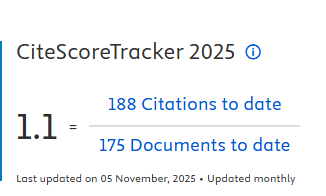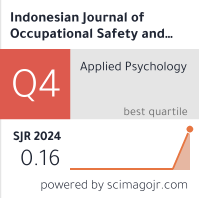Literature Review: Biological Monitoring of Occupational Tetrachloroethylene Exposure in Workers
Downloads
Introduction: One of the most common chlorinated solvents in the world is tetrachloroethylene (TCE) because it is widely used in various industries. Exposure to tetrachloroethylene can cause health problems so biological monitoring is necessary to do. The aim of this research is to assess which one is more feasible to use among the various types of biological monitoring for tetrachloroethylene exposure, based on the evidence-based literature. Methods: The literature searching was performed via electronic databases from PubMed, Scopus, and Proquest. The keywords used were "biological monitoring”, "biomonitoring”, "tetrachloroethylene”, "perchloroethylene”, "work” and "occupation”. The articles were chosen based on the given inclusion and exclusion criteria. Selected articles were then critically appraised. Results: Initially 29 papers were collected, but only6 cross-sectional articles were selected after the screening process and manual searching. Based on the selected evidence-based literatures, statistically meaningful associations were found between tetrachloroethylene exposure and tetrachloroethylene in blood in pre- and end-of-shift, in urine at end of shift, and in exhaled air at end-of-shift. Moreover, micronucleus frequency and DNA damages between dry cleaning workers and the controls differed significantly. Conclusion: The level of tetrachloroethylene in blood, urine, and exhaled air becomes an appropriate biological exposure index for assessing tetrachloroethylene exposure in dry-cleaning workers. In Indonesia, biomonitoring that is more feasible to be implemented is micronucleus frequency evaluation from buccal mucosal epithelial smears since it is a simpler, faster, and less expensive procedure.
Keywords: biological monitoring, biomonitoring, occupational exposure, tetrachloroethylene
ACGIH (2021) 2021 TLVs and BEIs Based on the Documentation of the Threshold Limit Values for Chemical Substances and Physical Agents & Biological Exposure Indices. Cincinnati: American Conference of Governmental Industrial Hygienists.
Azimi, M. et al. (2017) ‘Primary DNA Damage in Dry Cleaners with Perchlorethylene Exposure', International Journal of Occupational and Environmental Medicine, 8(4), pp. 224–231.
Barton, C. (2014) Tetrachloroethylene, Encyclopedia of Toxicology: Third Edition. Waltham, MA: Academic Press.
Bolognesi, C. et al. (2015) ‘Buccal Micronucleus Cytome Assay: Results of an Intra- and Inter- Laboratory Scoring Comparison', Mutagenesis, 30(4), pp. 545–555.
Cichocki, J. A. et al. (2016) ‘Target Organ Metabolism, Toxicity, and Mechanisms of Trichloroethylene and Perchloroethylene: Key Similarities, Differences, and Data Gaps', Journal of Pharmacology and Experimental Therapeutics, 359(1), pp. 110–123.
Dias, C. M., Menezes, H. C. and Cardeal, Z. L. (2017) ‘Use of Exhaled air as an Improved Biomonitoring Method to Assess Perchloroethylene Short-term Exposure', Environmental Research, 156, pp. 108–112.
Everatt, R. et al (2013) ‘Biomonitoring Study of Dry Cleaning Workers using Cytogenetic Tests and the Comet Assay', Journal of Occupational and Environmental Hygiene, 10(11), pp. 609–621.
Gold, L. S.et al. (2008) ‘Systematic Literature Review of uses and Levels of Occupational Exposure to Tetrachloroethylene', Journal of Occupational and Environmental Hygiene, 5(12), pp. 807–839.
Guha, N. et al. (2012) ‘Carcinogenicity of Trichloroethylene, Tetrachloroethylene, some other Chlorinated Solvents, and their Metabolites', The Lancet Oncology, 13(12), pp. 1192–1193.
Guyton, K. Z.et al (2014) ‘Human Health Effects of Tetrachloroethylene: Key Findings and Scientific Issues', Environmental Health Perspectives, 122(4), pp. 325–334.
Habib, S. et al. (2018) ‘Preliminary Study: Environmental Assessment of Perchloroethylene in Dry-Cleaning Facilities in the UAE', Journal of Environmental and Public Health, 2018, pp. 1–5.
Hopf, N. B. et al. (2019) ‘Biological monitoring of workers exposed to carcinogens using the buccal micronucleus approach: A systematic review and meta-analysis', Mutation Research - Reviews in Mutation Research, 781, pp. 11–29.
IARC (2014) Trichloroethylene, Tetrachloroethylene, and Some Other Chlorinated Agents, IARC Monographs on the Evaluation of Carcinogenic
Risks to Humans. Lyon: The International Agency for Research on Cancer.
Julianti, R. R. et al. (2019) ‘The effect of perchloroethylene (PCE) exposure toward frequency of micronucleus formation in buccal mucosal ephitelia of dry cleaning employees', Journal of Medicine (Bangladesh), 20(2), pp. 59–62.
Kawai, T., Sakurai, H. and Ikeda, M. (2018) ‘Further examination of log P ow -based procedures to estimate biological occupational exposure limits', Journal of Occupational Health, 60(6), pp. 453–457.
Lucas, D. et al. (2011) ‘Clinical impact assessment of chronic exposure to tetrachloroethylene in a population of 50 dry-cleaning workers', Arch. Mal. Prof. Environ, 72, pp. 439–448.
Macca, I. et al. (2012) ‘Biological monitoring of exposure to perchloroethylene in dry cleaning workers', Medicina del Lavoro, 103(5), pp. 382–393.
Manuele, F. A. (2005) ‘Risk Assessment and Hierarchies of Control', Profesional Safety, 50(May), pp. 33–39.
McKernan, L. T. et al. (2008) ‘Biological exposure assessment to tetrachloroethylene for workers in the dry cleaning industry', Environmental Health: A Global Access Science Source, 7(12), pp. 1–10.
Modenese, A. et al. (2019) ‘Evaluation of occupational exposure to perchlorethylene in a group of Italian dry cleaners using noninvasive exposure indices', International Journal of Environmental Research and Public Health, 16(16), pp. 1–12.
OCEBM (2021) Critical Appraissal Tools. Oxford: Oxford Centre for Evidence based Medicine.
Safe Work Australia (2020) Health Monitoring Guide for Tetrachlorethylene. Canbera: Publishing Agency for Safe Work Australia.
Tucker, J. D. et al. (2011) ‘Cytogenetic analysis of an exposed-referent study: Perchloroethylene- exposed dry cleaners compared to unexposed laundry workers', Environmental Health: A Global Access Science Source, 10(16), pp. 1–6.
Vlaanderen, J. et al. (2014) ‘Tetrachloroethylene exposure and bladder cancer risk: A meta-analysis of dry-cleaning-worker studies', Environmental Health Perspectives, 122(7), pp. 661–666.
Ziener, C. E. and Braunsdorf, P. P. (2014) ‘Trace analysis in end-exhaled air using direct solvent extraction in gas sampling tubes: Tetrachloroethene in workers as an example', International Journal of Analytical Chemistry, 3, pp. 1–10.

In order to be accepted and published by The Indonesian Journal of Occupational Safety and Health, Author(s) who submit an article should complete all the review process. The copyright of received articles assigned to the The Indonesian Journal of Occupational Safety and Health and Department of Safety and Health, Universitas Airlangga as publishers of the journal. The intended copyright includes the rights to publish articles in various forms (including reprints).
The Editorial Team of The Indonesian Journal Of Occupational Safety and Health and Department of Safety and Health strive to ensure that no errors occur in the articles that have been published, both data errors and statements in the article.
Users of this website will be licensed to use materials from this website following the Creative Commons Attribution-NonCommercial-ShareAlike 4.0 International License. No fees charged. Please use the materials accordingly.
------------------------------------------------------------------------------------------------------------------------------------------------------------------------------------------
Attribution ” You must give appropriate credit, provide a link to the license, and indicate if changes were made. You may do so in any reasonable manner, but not in any way that suggests the licensor endorses you or your use.
NonCommercial ” You may not use the material for commercial purposes.
ShareAlike ” If you remix, transform, or build upon the material, you must distribute your contributions under the same license as the original.







 How to Submit Articles in OJS
How to Submit Articles in OJS

























